My Journey to Explore All of Sweden’s National Parks
I’ve set out on a quest to visit each one of the Sweden’s 30 national parks. This journey is still in progress… but has already taken me through enchanting forests, along rugged coastlines and over majestic mountains. So far I’ve visited the ones listed below — each offering its own unique slice of Sweden’s natural beauty. Can’t wait for the next visit!
Why National Parks Matter
Sweden is home to 30 national parks, each offering a unique glimpse into the country’s diverse and breathtaking natural landscapes. Discover Sweden’s National Parks, from the beech forests of Söderåsen to the dramatic alpine world of Sarek. These parks showcase Sweden’s natural beauty in all its forms — sand dunes, magical forests, coral reefs (for the divers) and more. Best of all, the entry to all national parks and their Naturum visitor centers is completely free, making it easy for everyone to experience Sweden’s most cherished environments. Sweden does have the allemansrätten (freedoom to roam), so you fre to wander!
National parks protect fragments of nature that once covered all of Sweden. By preserving these ecosystems, they safeguard the country’s most valuable natural landscapes for future generations. These parks aren’t just about protection; they provide space for people to enjoy nature, whether through hiking, wildlife watching or simply relaxing in beautiful surroundings.
A Legacy of Conservation
The worlds oldest is Yellowstone National Park, which was established in 1872. However, Sweden was the first country in Europe to establish national parks, creating the first nine in 1909. Over 100 years later, there are now 30 parks that represent the very best of Sweden’s natural heritage. The creation of these parks has evolved over time — from romantic ideals of untouched wilderness to the use of scientific criteria to determine which areas deserve protection. Today, Sweden’s national parks range from pristine, untouched landscapes to areas where grazing animals and traditional meadow management help preserve old cultural landscapes.
These parks are a shared legacy, owned by the state and established with local communities in mind. Managed by the Swedish Environmental Protection Agency, they’re a testament to Sweden’s commitment to conservation and outdoor recreation.
Tiveden National Park
A Wilderness Steeped in History
Established in 1983 and expanded in 2017, Tiveden National Park spans over 2,030 hectares of pristine wilderness. The park’s goal is to preserve its rugged forest, lake and rift valley landscape in a largely untouched state, allowing the forest to naturally evolve into a primeval state.
Situated between Sweden’s two largest lakes, Vänern and Vättern, Tiveden has long been a place of mystery and legend. Historically, its dense forests and challenging terrain made it a natural boundary between regions and a haven for those seeking solitude.
Geological Characteristics
The park’s dramatic landscape is the result of ancient geological activity. Millions of years ago, shifts in the Earth’s crust created deep rift valleys and steep hills composed of granite bedrock. The last Ice Age sculpted the terrain further, scattering enormous boulders across the landscape and leaving behind giant’s kettles — deep, smooth holes carved by swirling glacial meltwater.
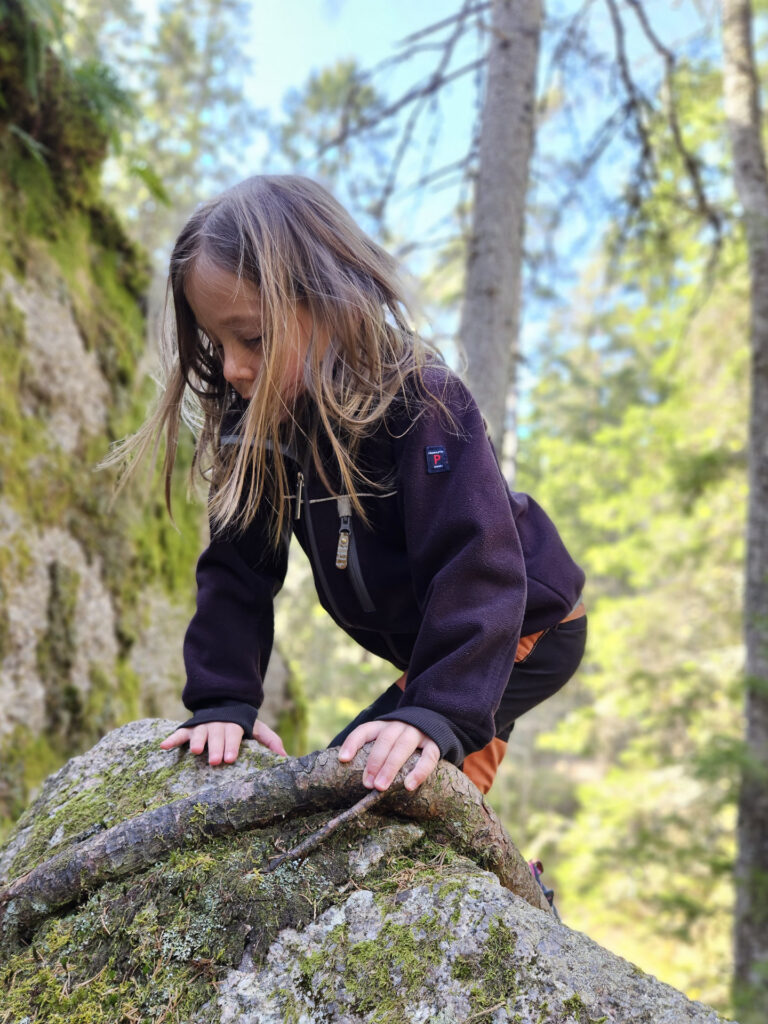
Flora and Fauna
Tiveden’s forests are a tapestry of old-growth pine and spruce trees, some reaching ages of 200 to 300 years. The thin soil supports a rich variety of mosses, lichens and shrubs like lingonberry and heather. In the sheltered valleys, you’ll find more lush vegetation, including hazel, wood anemone and various orchids.
Wildlife thrives here, with inhabitants like elk, roe deer, foxes and even wolves making the forest their home. Bird enthusiasts can spot species such as the capercaillie, owls, woodpeckers and eagles soaring above the treetops.
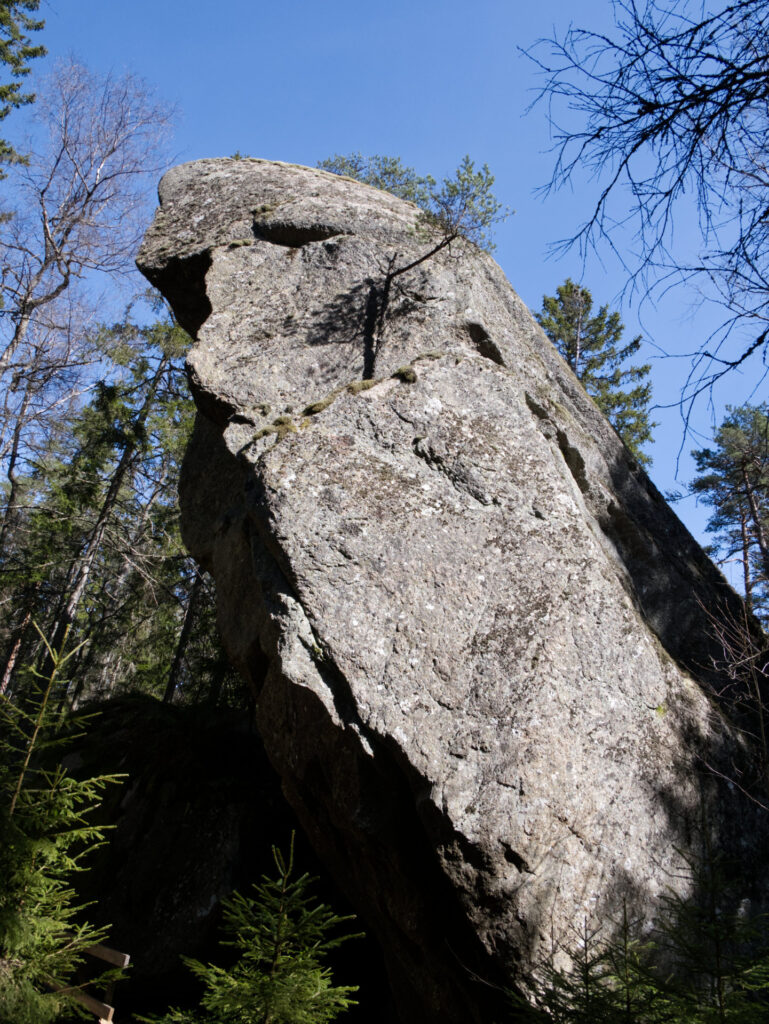
Our hike in Tiveden
Hiking through Tiveden felt like stepping into a fairy tale. The trails led us over moss-covered boulders, past tranquil lakes and through ancient forests. A highlight was visiting Stenkälla, a natural spring surrounded by towering rocks. The sense of history and untouched nature here is truly captivating.
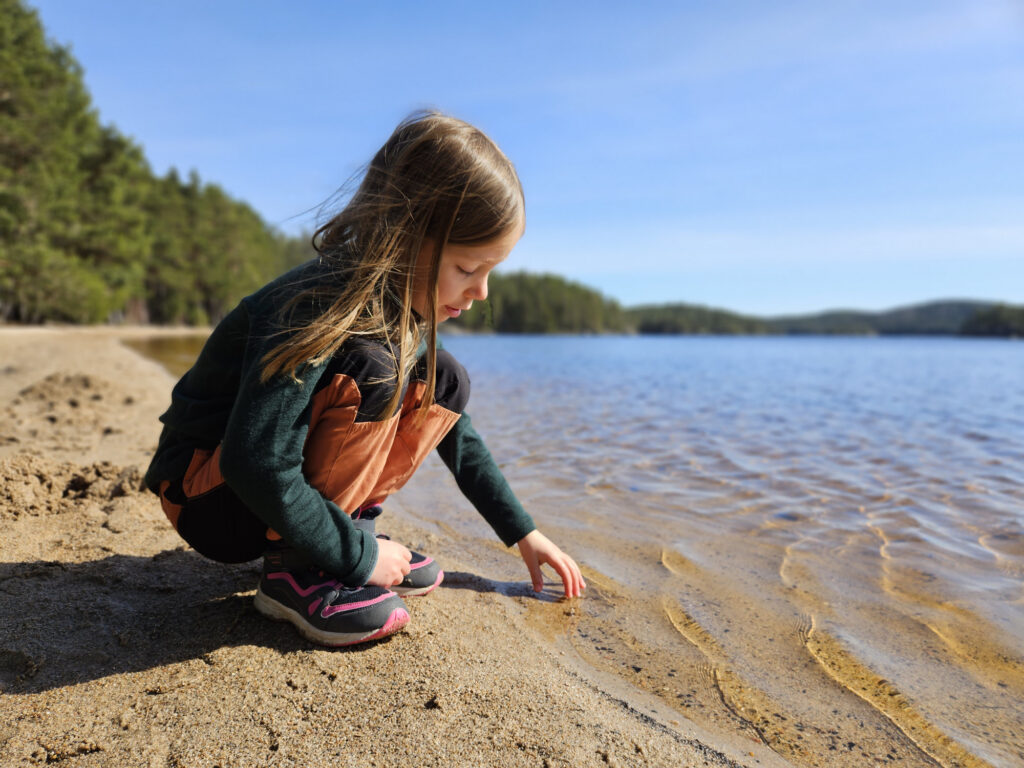
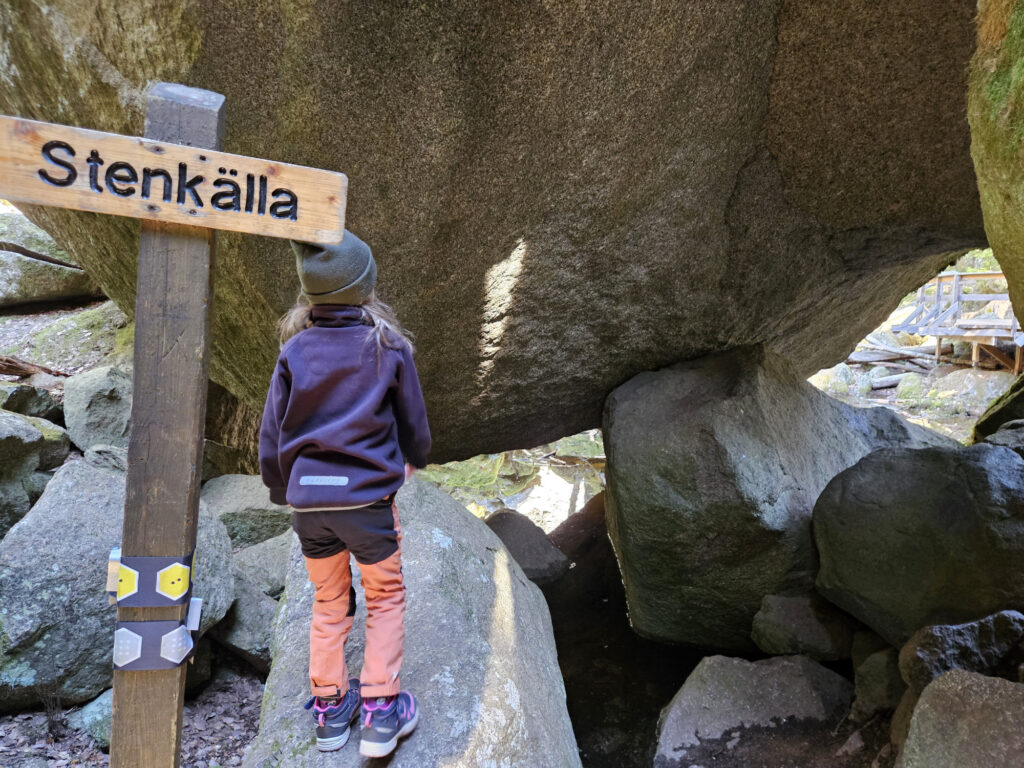
Tresticklan National Park
A Hidden Gem of Wilderness
Tresticklan National Park, established in 1996, covers 2,908 hectares of unspoiled wilderness along the Swedish-Norwegian border. The park aims to protect its unique rift valley landscape and extensive natural forests, offering a glimpse into Sweden’s wild past with minimal signs of human activity.
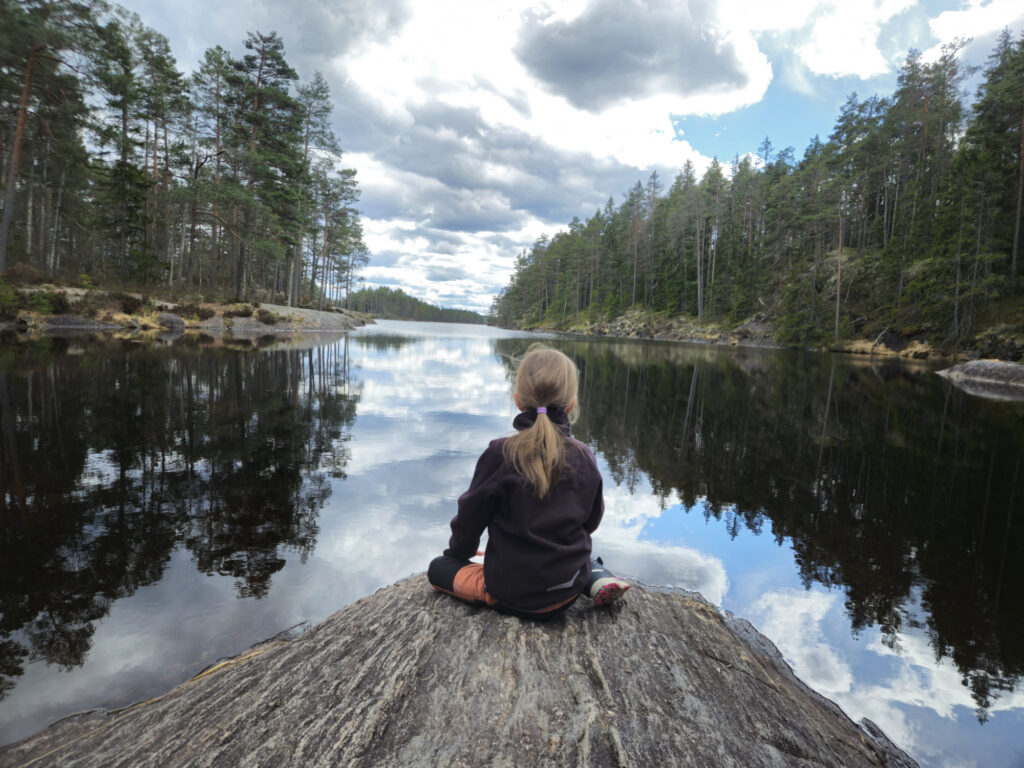
Rugged Terrain and Serene Lakes
The park is characterized by long, narrow mountain ridges made of ancient gneiss rock formations dating back over 1.6 billion years. Between these ridges lie deep valleys filled with over 90 lakes and tarns, most of which are small and secluded, creating a serene and remote atmosphere.
Vegetation and Wildlife
The flora in Tresticklan is adapted to the harsh conditions of the nutrient-poor soils. You’ll find hardy plants like bilberries, lingonberries and various mosses and lichens. Sturdy weathered pines cling to the rocky ridges, while spruce and deciduous trees such as birch and aspen populate the valleys.
Wildlife is abundant, with animals like elk, roe deer and beavers making their homes here. Notably, the park is part of an established wolf territory and while sightings are rare, their presence adds to the wilderness experience. Maybe that’s why I dreamt about wolves during our night in Budalsvika cabin. Birdlife includes species like the crested tit, black woodpecker, capercaillie and the elusive nightjar.
My Adventure in Tresticklan
This was a short hike through the Swedish National Park of Tresticklan over to the Budalsvika cabin in Norway just next to the border, literally over a small creek as you can see i the video. With one night to be spent there and hike back on the following day. Definitively a place to return to!
Tyresta National Park
Just 20 kilometers from the bustling city of Stockholm lies Tyresta National Park, home to an ancient forest filled with towering pines, serene silence and shimmering forest lakes. Established in 1993, Tyresta is one of the largest expanses of untouched forest south of the Dalälven River. Walking along trails that wind through the park, visitors can immerse themselves in a rare and majestic old-growth forest.
A Walk Through the Wilderness
As you enter the park from places like Tyresta by or Stensjödal, the vastness of the wilderness is immediate. The park is dominated by centuries-old gnarled pine trees and towering spruces. Fallen trees, hollow trunks and young saplings contribute to a rich ecosystem that provides shelter and sustenance for a variety of species. It is no surprise that Tyresta is often referred to as the kingdom of capercaillie and owls.
The park is home to a range of wildlife, from elusive species like wild boars, beavers and deer, to birds such as woodpeckers, redstarts and owls. Although many of these creatures are shy and rarely seen, visitors are often struck by the profound silence of the forest. Berry picking and mushroom foraging are popular activities in Tyresta, though picking flowers and plants is not permitted.
A Wilderness Close to Stockholm
Despite its proximity to the city, Tyresta’s wilderness offers an authentic sense of isolation. From the shores of lakes and scenic viewpoints, you can take in the sweeping landscape of wild, untamed forest. The park offers several hiking trails, with paths ranging from 2.5 km to 14 km, including sections of the famous Sörmlandsleden trail. This makes Tyresta easily accessible for day-trippers from Stockholm via bus or train.
While there, don’t miss the opportunity to visit Tyresö Castle!
A Thriving Wildlife Habitat
The rolling terrain of Tyresta provides a haven for a rich diversity of wildlife. While large mammals like moose and deer may leave tracks in the snow, the park’s birdlife is more easily observed. Black woodpeckers and capercaillies are the park’s emblematic residents, along with common species such as robins, chaffinches and willow warblers. The park’s lakes echo with the haunting call of the red-throated diver, while owls, such as the tawny owl, eagle owl and pygmy owl can be heard in the early morning or late evening.
Beavers and wild boars are some of Tyresta’s more active residents. Beavers have established themselves around the park’s lakes, creating dams and felling trees, while wild boars are known for rooting through the soil in search of food. Their presence is often marked by the visible upheaval of the forest floor.
A Botanist’s Paradise
Tyresta’s plant life, though sparse in diversity, thrives in the park’s old-growth conditions. The forest is rich with mosses, lichens and fungi, particularly in areas like the wet marshlands where fragrant plants such as bog myrtle and wild rosemary grow. In the summer months, these plants release sweet aromas that waft through the forest.
Rare species such as club moss, lesser twayblade and spider orchid are characteristic of the old-growth environment. The park is also a mushroom-lover’s paradise, with species like chanterelles, porcini and various boletes found throughout. Thanks to the abundance of decaying wood, rare fungi such as the rosy polypore and silky rosette thrive on fallen trees and stumps.
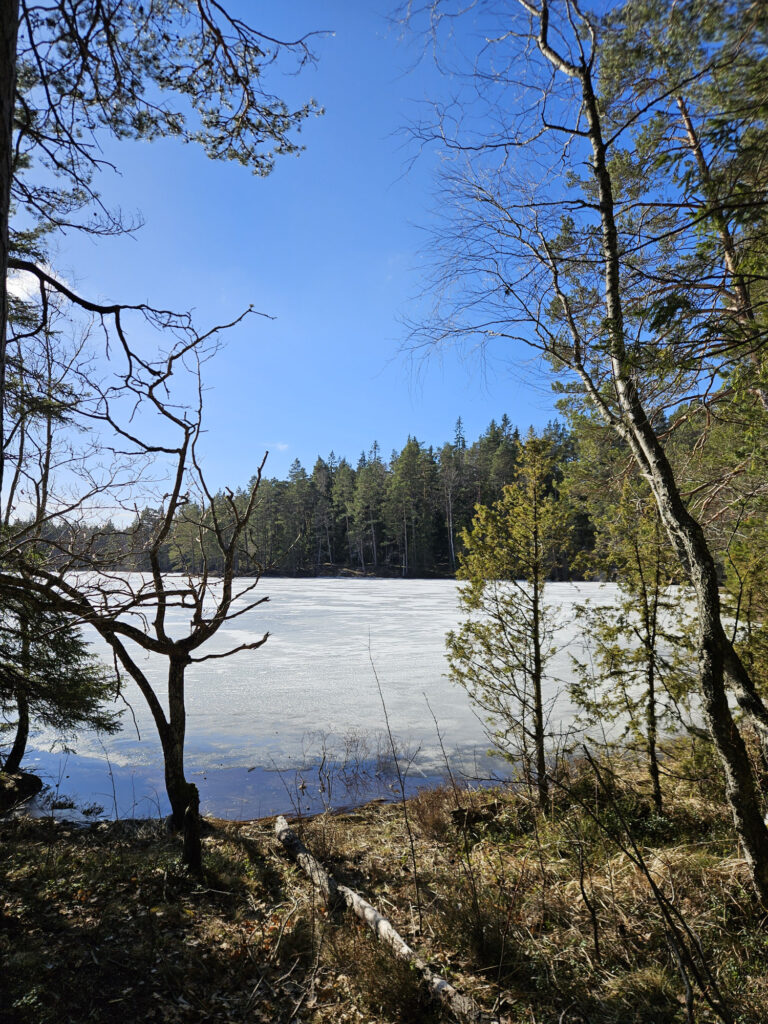
A Landscape Shaped by Fire and Ice
Tyresta is characterized by a unique fracture valley landscape, shaped over millions of years and prominent throughout central Sweden and eastern Finland. This geological foundation is responsible for the varied landscapes within the park, from rocky pine forests to dense spruce woods and tranquil lakes.
The ancient bedrock plateau that forms Tyresta was created an astounding 1.8 billion years ago. Glaciers from the last ice age carved the valleys and left behind smoothed rock surfaces and scattered boulders, evidence of the immense pressure and movement of the ice. These valleys, filled with moraine and sediment, now support the park’s lush forests and wetlands. Some valleys have filled with water, forming the park’s lakes and streams.
Human History and Cultural Significance
Though now a pristine wilderness, Tyresta has long been inhabited by humans. Evidence of early hunters can still be found, with stone tools dating back to the Stone Age. Iron Age burial sites, Viking remains and traces of 19th-century farmers all point to a long history of human activity in the area. There is a main ancient spot as seen in the video with the great overview of the lake and the landscape around.
Old border markers, stone cairns and tree markings reveal how the land was divided and used by different groups throughout history. Today, visitors can see Iron Age burial mounds near Tyresta by, as well as a famous runestone dated to around 1070 AD, inscribed with a cross and a depiction of a capercaillie.
Celebrating Biodiversity
Tyresta’s rich biodiversity is a testament to its ancient, untouched forests. Over the years, researchers have identified thousands of species living within the park, including nearly 900 invertebrates, 350 vascular plants, 400 fungi, 160 lichens, 300 mosses and 80 bird species.
A Forest of Life and Death
The dead trees in Tyresta provide vital habitats for many species, offering shelter and food to insects, birds and fungi. These ancient trees, both standing and fallen, create a rich tapestry of life that is absent from managed forests. In this wilderness, every tree, from the youngest sapling to the oldest giant, plays a crucial role in supporting the ecosystem.
Tyresta National Park stands as a stunning example of the ancient forests that once covered much of Sweden. Its rich biodiversity and untouched landscapes make it a unique destination for anyone looking to experience the wild beauty of Sweden’s natural heritage.
The forest fire that swept through Tyresta National Park in 1999 left a lasting mark on both the landscape and the memories of Stockholm residents. What was once a scene of destruction has transformed into a place of renewal, where new life emerges from the ashes.
Stenshuvud National Park
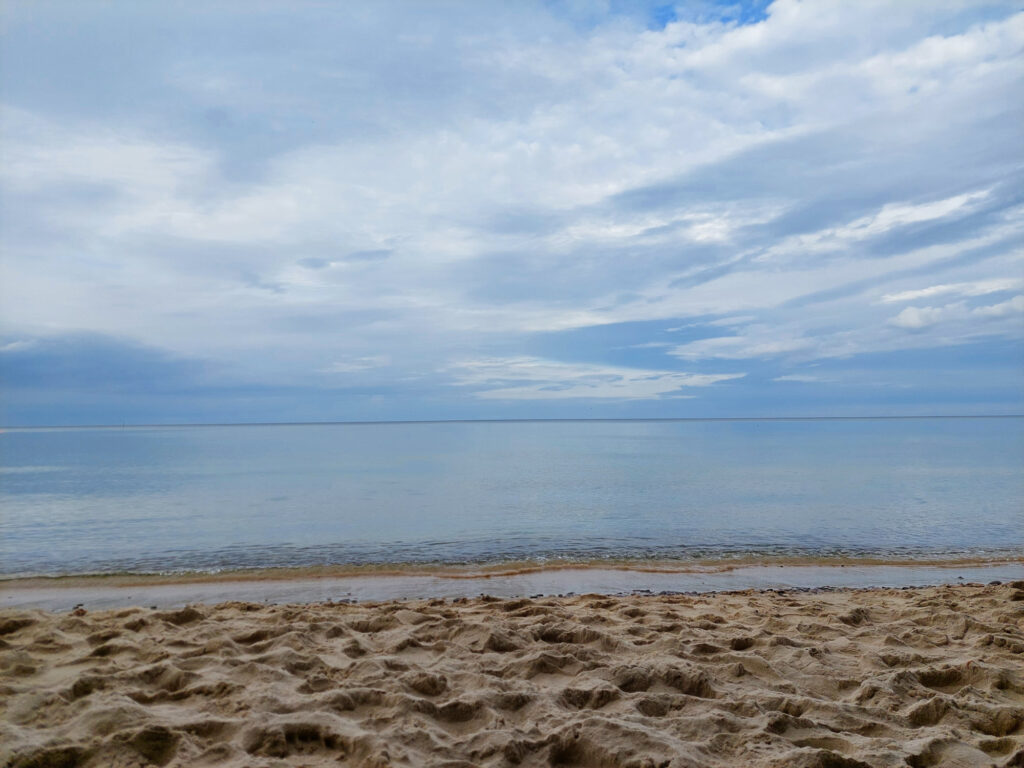
Stenshuvud National Park, formed in 1986, sits in the southeastern part of Skåne and offers an enchanting mix of coastal beauty and forested tranquility. The park’s heart is the mountain Stenshuvud, with its highest peak reaching 97 meters above sea level. The mountain itself is an inselberg, a rare geological feature formed by millions of years of erosion and the surrounding landscape includes everything from sandy beaches and rocky coastlines to wetlands and lush deciduous forests.
A Journey Through Time and Nature
Stenshuvud has been a natural and cultural meeting point for millennia, home to ancient castle walls from the Iron Age and stone mounds from the time of early farming. The area first gained protection in 1931 as a natural monument and was gradually expanded until it became a national park in 1986. Grazing livestock are still used to maintain the open fields and meadows, blending historical land use with modern conservation efforts.
A Rich Diversity of Flora and Fauna
With around 600 species of plants, including rare varieties like the sand pink and barren strawberry, Stenshuvud’s plant life flourishes in the park’s diverse environments — from hornbeam forests to orchid meadows and sandy heathlands. Spring brings a vibrant display of wood anemones and ramsons, while autumn transforms the heath into a sea of purple heather. Wildlife thrives here too, with roe deer, foxes and even the elusive hazel dormouse making their home in the park’s rich forests.
Söderåsen National Park
Located in southern Sweden, Söderåsen National Park stands out with its lush beech forests, dramatic ravines and sweeping views over Skåne’s rich landscapes. Established in 2001, this park covers 1,625 hectares and offers a vivid glimpse into the natural world of southern Sweden, a region shaped by millions of years of geological activity.
A Park Born From Conservation Efforts
The preservation of Söderåsen began in the 1960s when local authorities realized the unique natural beauty and ecological significance of the area. By the 1980s, state acquisition of the land had begun and the dream of creating a national park became a reality in 2001 when the Swedish government officially established it. Today, Söderåsen’s diverse ecosystems and geological features are protected for future generations to enjoy.
Geological Wonders and Breathtaking Landscapes
Söderåsen is a horst, a raised block of the earth’s crust, formed around 400 million years ago. The park is famous for its dramatic rift valleys, steep slopes and rocky outcrops. The Skäralid gorge, with its towering cliffs and lush vegetation, is one of the park’s most iconic features. As you hike through the park, you’ll see the result of ancient geological forces, with gneiss and granite rock formations that create a striking backdrop.
Another geological highlight is the basalt columns near Skäralid, a reminder of the region’s volcanic past. The valley of Nackarpsdalen with its peaceful Odensjön adds another layer of serenity to the park’s diverse landscapes.
A Rich Mosaic of Flora and Fauna
Söderåsen is home to an incredible variety of plant and animal species, many of which are rare or endangered. The park’s forests are a mix of beech, oak and ash trees, creating a lush canopy that shelters countless species of plants and animals. In the damp ravines, you’ll find alder and elm, along with ferns, mosses and fungi that thrive in the cool moist environment.
The park’s wildlife is equally diverse, with deer, wild boar, badgers and foxes roaming the forests. Birdwatchers will be delighted by species like the lesser spotted woodpecker, hawks and owls. The park is also known for its rich insect life, including the rare red-necked longhorn beetle, which depends on the park’s old-growth trees and dead wood for survival.
Water – A Vital Force
Water plays a key role in Söderåsen’s ecosystems. Streams like Skärån and Dejebäcken run through the park, supporting an array of fish and aquatic life, such as trout, eels and freshwater lampreys. Odensjön, the park’s only natural lake, is a pristine body of water with crystal-clear reflections of the surrounding forests.
In 2019, an ecological restoration project saw the construction of a bypass channel around Skärdammen, which had previously blocked fish migration. This new bypass now allows fish to move freely, improving the park’s biodiversity and creating opportunities for visitors to engage with educational activities related to aquatic life.
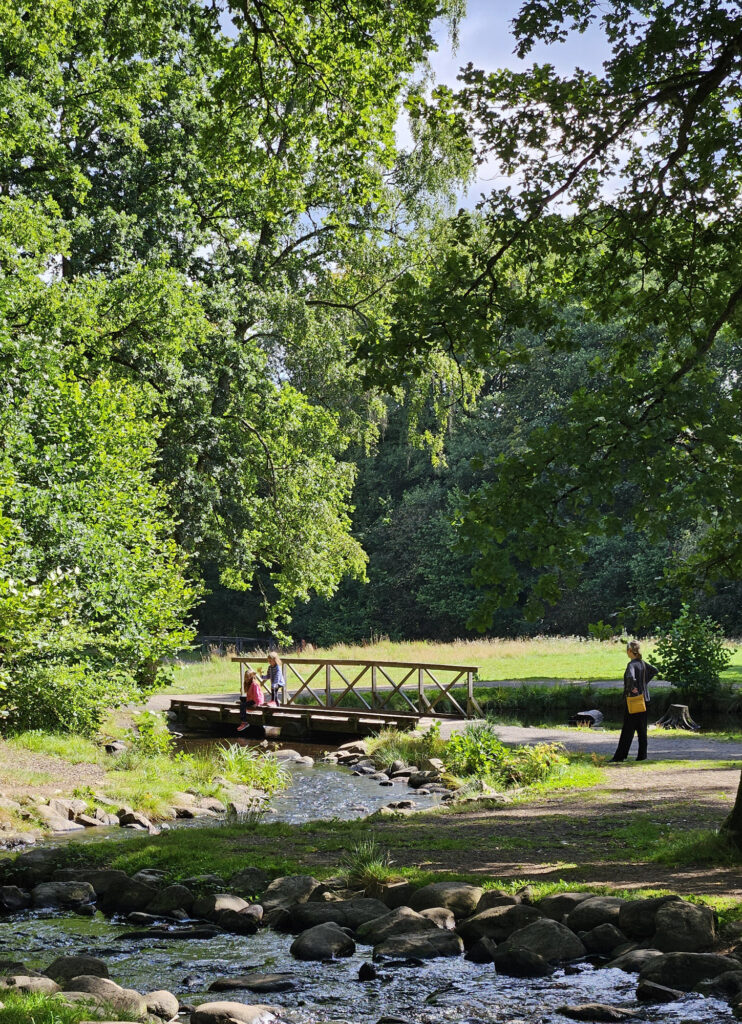
Exploring Söderåsen
During my visit, I was captivated by the towering cliffs of Skäralid and the peaceful beauty of Odensjön. The park’s network of trails offers something for everyone — from gentle walks through beech forests to more challenging hikes with panoramic views from the top of Kopparhatten, the highest point in the park. Whether you’re interested in geology, wildlife, or simply soaking in the tranquility of nature, Söderåsen is a must-visit.
Dalby Söderskog National Park
Nestled in “south of southern” Sweden, Dalby Söderskog National Park offers an enchanting snapshot of southern deciduous forests. Established in 1918, this is one of the oldest national parks in Sweden, created to preserve what was then considered a typical southern Swedish broadleaf forest.
A Glimpse Into the Past
Historically, Dalby Söderskog wasn’t always a dense forest — it was once a grazing area where oaks and beeches stood tall amidst lush meadows. Known as “Hästhagen” in the early 19th century, this area was used for grazing horses belonging to both the local monastery and the Danish royal court during the Middle Ages.
Flourishing Springtime Bloom
Dalby Söderskog is perhaps at its most beautiful in the spring when the forest floor is blanketed in vibrant carpets of yellow and white wildflowers. Visitors flock to the park for picnics amidst the season’s first blooms of anemones, celandine and lesser celandine. These flowers thrive before the leaves of the towering trees above fully emerge, allowing the sunlight to reach the ground and kick-start this colorful display.
As summer approaches, the spring flowers give way to a lush green undergrowth and the park transforms into a serene haven for both plant and animal life. The park is known for its distinctive Hollowroot, a delicate plant that blossoms in hues of pink and white in the park’s southern parts.
A Forest Left to Its Own Devices
When the park was established, grazing and logging ceased, allowing the forest to grow freely without human intervention. Over time, the open forests began to fill in and the once-dominant oaks have given way to a more diverse canopy of beech, ash and elm trees. Sadly, Dutch elm disease has ravaged many of the old elms, leaving gaps in the forest canopy that have allowed young ash trees to thrive.
A Diverse Ecosystem
Dalby Söderskog is not only a haven for plant life but also a hotspot for biodiversity. The forest’s dead wood and fallen trees provide vital habitats for various species of insects, fungi, mosses and lichens. Birds thrive here, with woodpeckers like the black woodpecker and the green woodpecker making their homes in the park’s dead trees. Their abandoned nests are later taken over by other birds and even squirrels.
A Park in Constant Evolution
The landscape of Dalby Söderskog continues to evolve as it is shaped by natural forces rather than human activity. As a result, visitors today experience a different forest than the one envisioned when the park was first established. The next generation of visitors will likely witness a forest that has grown even closer to the untamed wilderness that once dominated this region.
My Visit to Dalby Söderskog
As far as hiking it’s a walk in the park and a very flat one at that. I’d recommend visiting Dalby Söderskog while visiting Söderåsen’s National Park. Of course, while you’re in the area visiting other sites in Skåne is a given.
Store Mosse National Park
I had imagined visiting Store Mosse on a frozen winter’s day, with the landscape bathed in the glow of a clear starry moonless sky. The silence, broken only by the crunch of frosty icy snow layer underfoot. But as luck would have it, I ended up there on a rainy day way too early for winter. Walking the trail during a break in the downpour — only to have the rain return just as I was heading back to the car. Despite the wet weather, the visit was pretty interesting. It’s a huge bog, vast and flying the drone over it really brought me another angle of it.
Store Mosse National Park is the largest expanse of peat bog in southern Sweden, preserving one of the region’s most remarkable and ancient landscapes. Located in Småland, this park spans nearly 7,682 hectares of pristine wetlands, forests and lakes, providing a unique window into an ecosystem that has remained largely untouched for thousands of years.
A Peat Bog Thousands of Years in the Making
The vast bogs of Store Mosse have been forming over the last 8,000 years, with layers of Sphagnum moss and peat creating a rich and complex ecosystem. Originally, the area was part of a large glacial lake known as Fornbolmen, which covered much of western Småland about 15,000 years ago. As the land rebounded and the lake drained, sand deposits were left behind on the former lakebed. Over time, parts of this sandy plain became waterlogged, allowing peat moss to establish and forming what is now one of southern Sweden’s largest raised bogs.
The high peat bog itself supports a remarkable array of plant life adapted to this acidic, low-nutrient environment. Carnivorous plants, including three types of sundews, thrive here alongside over 20 varieties of Sphagnum moss. Hardy shrubs such as heather, cranberry and bog myrtle add to the unique vegetation. In wetter areas, the landscape is blanketed with vibrant haircap moss, which contrasts with the sparse, stunted pines resilient enough to survive in this challenging habitat.
Store Mosse’s geology also reveals traces of metabasite — a mineral-rich rock that emerges in places like Lilla Lövö — and a layer of limestone beneath Björnekullakärret, enriching the soil in these areas and allowing for the growth of calciphile (lime-loving) plants.
Restoring the Legacy of Store Mosse
Store Mosse has seen significant conservation efforts, most notably the completed restoration of Kävsjön and Häradsösjön, which had been heavily impacted by lake drainage in the 19th century. The lakes, once drained to create agricultural land, were returned to their natural state through careful management of water levels and the clearing of overgrown vegetation. These restoration efforts have rejuvenated wetland habitats, allowing the lakes to support a wide diversity of birdlife once more. From waders to migratory species that use the restored shoreline as a seasonal resting spot.
A Haven for Birdlife and Wildlife
Store Mosse is home to a wealth of bird species, with Kävsjön as a central site for birdwatching. Here, you’ll find iconic species such as cranes, whooper swans and the curlew, the park’s symbolic bird. Birds of prey, including the golden eagle and white-tailed eagle, make regular appearances, especially during the winter months when they are drawn to the area.
In addition to birdlife, the park hosts larger mammals like moose, roe deer and occasional lynx, while six species of bats flutter across the evening sky. The park’s rich insect population, fostered by extensive deadwood, attracts woodpeckers, which thrive in this biodiverse environment.
Exploring Store Mosse
Despite the rain during my visit, I was struck by the quiet beauty of Store Mosse’s trails. Paths like the Lövö and Svänö loops lead visitors through varying landscapes of bogs, marshes and dense woodlands. Observation towers around Kävsjön offer stunning views of the wetlands, ideal for birdwatchers and nature enthusiasts alike.
Store Mosse National Park is a testament to the resilience of nature, preserving the beauty of an ancient bog landscape for all to enjoy. With its tranquil bogs, thriving wildlife and rich ecological history, the park offers an unforgettable experience — a journey into one of Sweden’s most extraordinary natural treasures.
Åsnens National Park
It may not be Sweden’s largest, but as one of the smallest and newest parks (established in 2018), it offers a unique and easily accessible hiking experience. Covering 1,869 hectares, 75% of which is water, Åsnen is a compact haven for nature lovers, with shorter hikes that allow you to explore its rich landscapes in just a few hours. All in all very family friendly.
I had hoped to experience Åsnen under sunny skies, but true to form, my hike took place in a lull between rain showers. Even with the clouds looming overhead and the damp ground underfoot, the landscape felt inviting. The park’s varied terrain, from lakeshores and woodlands to clusters of tall trees provided enough to keep me captivated until the rain made its inevitable return as I headed back to my car.
Ancient Forests and Rich Biodiversity
One of Åsnen’s highlights is the old-growth forest of Bjurkärr located near the Sunnabron entrance. Known for its high biodiversity, Bjurkärr is a well-preserved stretch of forest featuring abundant mosses, lichens, fungi and insects that thrive on decaying wood. These forest habitats are home to many rare species, including several that depend on the presence of old, dead trees for survival.
Among the tall impressive trees in Åsnen the towering oaks stand out. Planted centuries ago for the Swedish Navy’s shipbuilding needs, these oaks were meant to supply the durable timber necessary for constructing large wooden ships. While modern shipbuilding moved away from oak, these grand trees remain as a testament to a bygone era.
Diverse Flora and Fauna
Åsnen is listed as a wetland of international importance under the Ramsar Convention, highlighting its role as a crucial site for birds. Species such as ospreys, white-tailed eagles, hobby falcons and black-throated divers are commonly sighted here. The park’s shallow, fish-rich waters also attract birds for nesting, resting and wintering. Making it a significant hub for avian biodiversity.
In addition to birds, Åsnen’s older trees and hollow trunks support a variety of rare insects, such as the endangered beech longhorn beetle. Larger mammals, including moose, roe deer, wild boar and the elusive otter. Make their home within the park’s forests and shores. Six species of bats are also known to inhabit the area, with Bjurkärr being one of the best spots to catch a glimpse of them in action on summer nights.
Exploring Åsnens Trails
Åsnen’s trail system offers a mix of forest walks and lakeside paths, with routes leading hikers through serene woodlands and along rocky shores. Trollberget, on the park’s western side, is a favorite for families, providing a charming forest walk with just the right amount of intrigue for young explorers. Trails from the Sunnabron and Bjurkärr entrances are ideal for those looking to experience Åsnen’s combination of island archipelago views, peaceful wetlands and towering forest trees.
Åsnens National Park provides an inviting landscape that highlights the quiet beauty of southern Sweden’s natural spaces. Whether under a clear sky or between rain showers, Åsnen offers a memorable experience for anyone seeking a peaceful retreat into nature.








What do you think?